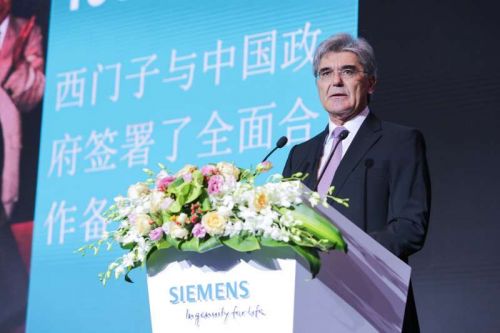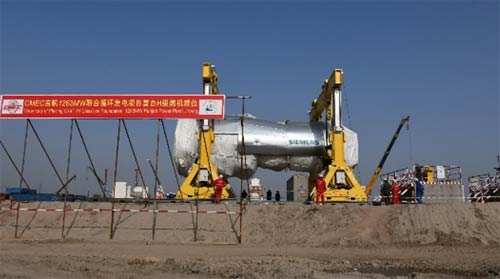

The flourishing development of the China-proposed Belt and Road Initiative has gone beyond win-win cooperation. Now it is “triple win” and China has renewed its call on international big names to join the feast.
The term, “triple win,” was first brought up by Joe Kaeser, President and CEO of Siemens AG, in Beijing on Wednesday at the Belt and Road International Summit 2018, which was hosted by the German conglomerate.
An open, fair and collaborative participation in the Belt and Road Initiative and the Digital Silk Road projects - more open to local companies in the BRI countries - said the the president, would send a powerful message to the rest of the world that together we can build a better world. “This is what I call a triple win!”

(Joe Kaeser, President and CEO of Siemens AG, addresses the Wednesday Belt and Road International Summit 2018. Photo courtesy of Siemens)
Speaking at the summit, Kaeser called the Belt and Road Initiative a landmark movement and the biggest infrastructure project of all time, as it generates opportunities in almost every factor, representing a 1 trillion euro investment in infrastructure in about 90 countries and beyond and has the potential to improve the lives of 70 percent of the world population.
In 2017 alone, Chinese companies inked 7,217 new contracts in 61 countries and regions, with a total volume of $144.3 billion, according to the nation’s Ministry of Commerce.
Zhou Xiaofei, deputy secretary general of National Development and Reform Commission (NDRC), also revealed at the summit that a total of 9,000 trips of China Railway Express (CR Express) have been made to some 42 cities in 14 European countries.
The NDRC official noted that the Belt and Road Initiative can integrate the advanced technology and resources of foreign and Chinese companies to meet the demands in underdeveloped regions.
“We welcome more foreign companies to join the R&D, production and investment under the Belt and Road,” he said, adding that Siemens has served a good example in this regard.
Wang Jianjun, director general of foreign capital and overseas investment department at NDRC, pointed out that such cooperation between Chinese and foreign companies on major project construction is also part of the third-party cooperation mechanism, which is actively supported by the commission.
In Kazan, Turkey, China Tianchen Engineering Cooperation helped build one of the world’s largest soda ash factories, which is also a landmark equipment factory in the area.
In Jhang, Pakistan, the China Machinery Engineering Cooperation helped set up Jhang Power Plant, whose generation capacity could equal the total power consumption of 4 million local households. Both projects saw cooperation between Chinese companies and Siemens, which supplied turbines and generators for project construction.

(Jhang 1263 MW Combined Cycle Power Plant. Photo courtesy of Siemens)
From the perspective of countries along the Belt and Road, Wismana Adi Suryabrata, deputy minister of Infrastructure Affairs of Bappenas Indonesia, said at the summit that the initiative can integrate with the nation’s Global Maritime Fulcrum, which is designed to build several economic and energy hubs on its islands with a total volume of $51.63 billion.
Oti Ikomi, CEO of Proton Energy in Nigeria, pointed out that Africa also sees the Belt and Road as positive with more Chinese companies’ and entrepreneurs’ investment on the continent on the rise and infrastructure plans implemented, including the Nairobi-Mombasa Railway in Kenya.
“These examples have never more important than today because we live in a time when long-standing agreements and alliances are being challenged, a time when nationalism and protectionism are on the rise. There is sometimes when the lack of competitiveness is confused with unfair trade allegation. The right answer to lack of competitiveness is innovation and productivity.” Kaeser told the summit.
 Fire brigade in Shanghai holds group wedding
Fire brigade in Shanghai holds group wedding Tourists enjoy ice sculptures in Datan Town, north China
Tourists enjoy ice sculptures in Datan Town, north China Sunset scenery of Dayan Pagoda in Xi'an
Sunset scenery of Dayan Pagoda in Xi'an Tourists have fun at scenic spot in Nanlong Town, NW China
Tourists have fun at scenic spot in Nanlong Town, NW China Harbin attracts tourists by making best use of ice in winter
Harbin attracts tourists by making best use of ice in winter In pics: FIS Alpine Ski Women's World Cup Slalom
In pics: FIS Alpine Ski Women's World Cup Slalom Black-necked cranes rest at reservoir in Lhunzhub County, Lhasa
Black-necked cranes rest at reservoir in Lhunzhub County, Lhasa China's FAST telescope will be available to foreign scientists in April
China's FAST telescope will be available to foreign scientists in April "She power" plays indispensable role in poverty alleviation
"She power" plays indispensable role in poverty alleviation Top 10 world news events of People's Daily in 2020
Top 10 world news events of People's Daily in 2020 Top 10 China news events of People's Daily in 2020
Top 10 China news events of People's Daily in 2020 Top 10 media buzzwords of 2020
Top 10 media buzzwords of 2020 Year-ender:10 major tourism stories of 2020
Year-ender:10 major tourism stories of 2020 No interference in Venezuelan issues
No interference in Venezuelan issues
 Biz prepares for trade spat
Biz prepares for trade spat
 Broadcasting Continent
Broadcasting Continent Australia wins Chinese CEOs as US loses
Australia wins Chinese CEOs as US loses